Visit Spain’s capital city and you’ll be rewarded with art, literature and some seriously good food. Here’s why Madrid is worth visiting.
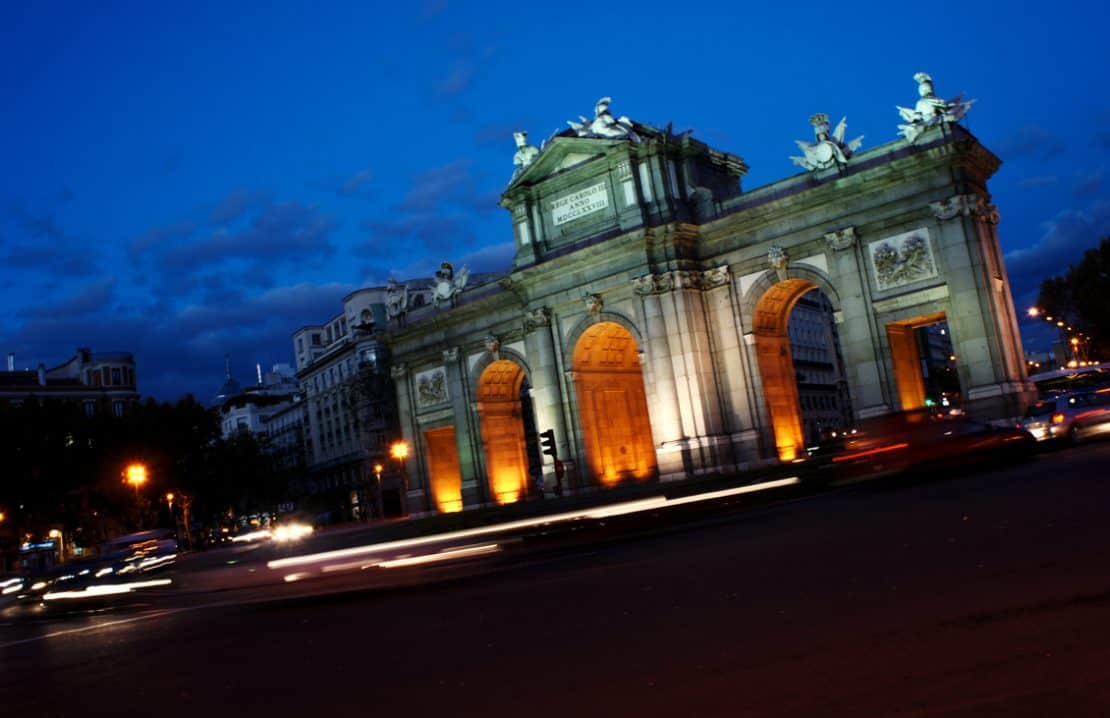
About Madrid
At golden hour in Madrid, the light softens the sharp edges of the Puerta del Sol. It lingers on the bronze bear and strawberry tree statue, kisses the paving stones warm, and hushes the hum of a Spanish guitar beneath a lilac sky.
The Spanish capital, with its regal façades and tireless energy, exhales into the evening. Yet travellers often ask whether Madrid is worth visiting at all.
Barcelona dazzles with beaches. Seville seduces with sultry flamenco. Madrid? Madrid is often perceived as the practical sibling: the capital city, yes, but not a dreamer’s destination.
So…is it worth watching, exploring, experiencing? What lies beneath the surface of this great city, and what can travellers find if they give it time?
Let’s take a closer look at the best places you can enjoy when visiting Madrid.
As soon as you are ready, head here to look for flights to Madrid.
Is Madrid Worth Visiting? Culture, History, and Soul
Madrid became the capital back in 1561, not because of any grand cathedral or heroic battlefield, but because of geography.
The Spanish king at the time, Philip II, wanted something more central. So, he picked this dry patch of land on the Castilian plateau, surrounded by oak forests and plains, and built a capital from it.
No sea views, no Roman ruins – just the beginnings of a stronghold for a modern Spain.
That sense of quiet confidence still lingers in the air. You feel the weight of Spanish history walking down the Paseo del Prado or beneath the watchful gaze of the Royal Palace of Madrid.
This is a city that shaped empires and revolutions, whose grand architecture tells a story of royal ambition, Enlightenment ideals, and hard-won democracy. And if you need more convincing, these interesting facts about Madrid are a great place to start.
Here’s what not to miss.
The Heart of the City: Puerta del Sol & Plaza Mayor
Madrid’s heart beats strongest where history meets hustle. Both Puerta del Sol and Plaza Mayor brim with movement at nearly every hour. They’re the perfect spot to grasp how the Spanish city balances tradition and modernity with casual grace.
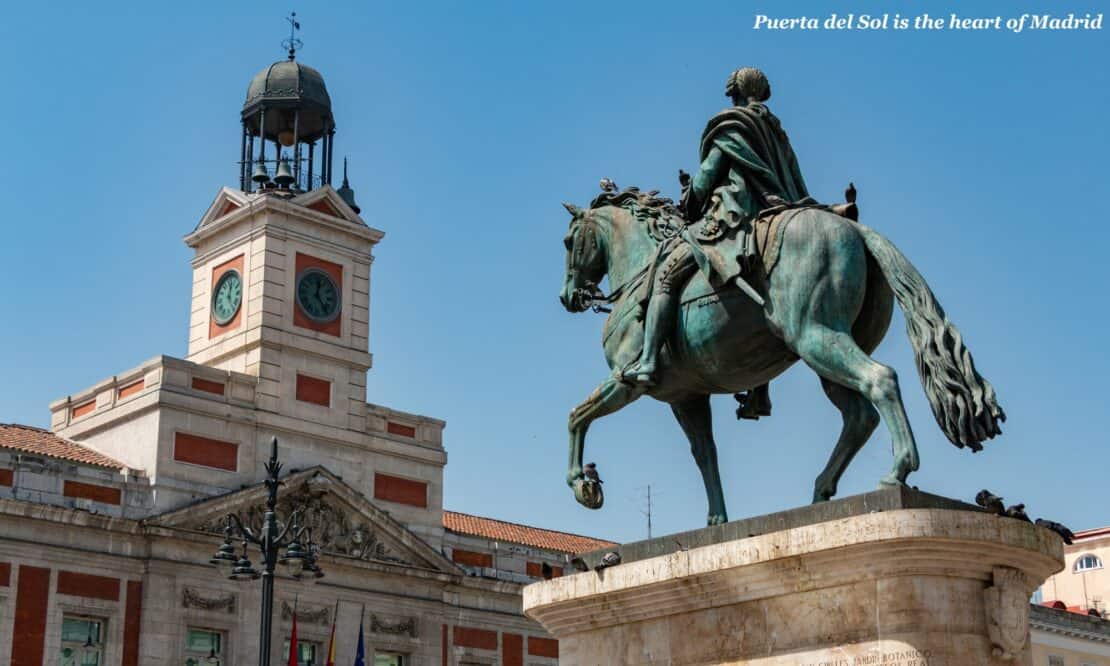
Puerta del Sol
Street performers, bustling crowds, and a plaque marking “Kilómetro Cero” define this famous square. People watch from café terraces or wander into shops just steps away from major train station connections.
While many call it a popular tourist destination (and for a good reason), locals also gather here to celebrate New Year’s Eve or plan weekend outings.
If you’re after a snapshot of the city centre’s lively soul, this is it – and from here, it’s only a short walk to Gran Vía, Madrid’s grand boulevard of theatres, shops, and shining lights.
Plaza Mayor
Stroll a few minutes from Puerta del Sol, and you’ll land in Plaza Mayor. Arcaded walkways frame a wide-open square, where cultural events unfold throughout the year: Christmas markets in winter, artisan fairs in summer.
Grab a table at one of the street cafés, order a plate of jamón ibérico, and watch street performers entertain passers-by.
With pastel-coloured façades and the statue of King Philip III presiding over the scene, the plaza offers a peek into the heart of the city’s rich cultural heritage, reminding you that Madrid’s vibrant past still pulses through its busiest corners.
World-Class Museums for Art Lovers and Enthusiasts
The Spanish capital consistently ranks among Europe’s top cultural hubs, thanks to its world-class museums. Together, these institutions form a treasure trove for art aficionados, unveiling Spanish history as told by some of the greatest painters in the world.
If you’re an art enthusiast on a first trip, you’ll quickly see why Madrid holds its own among other popular destinations with iconic museums catering to a range of tastes.
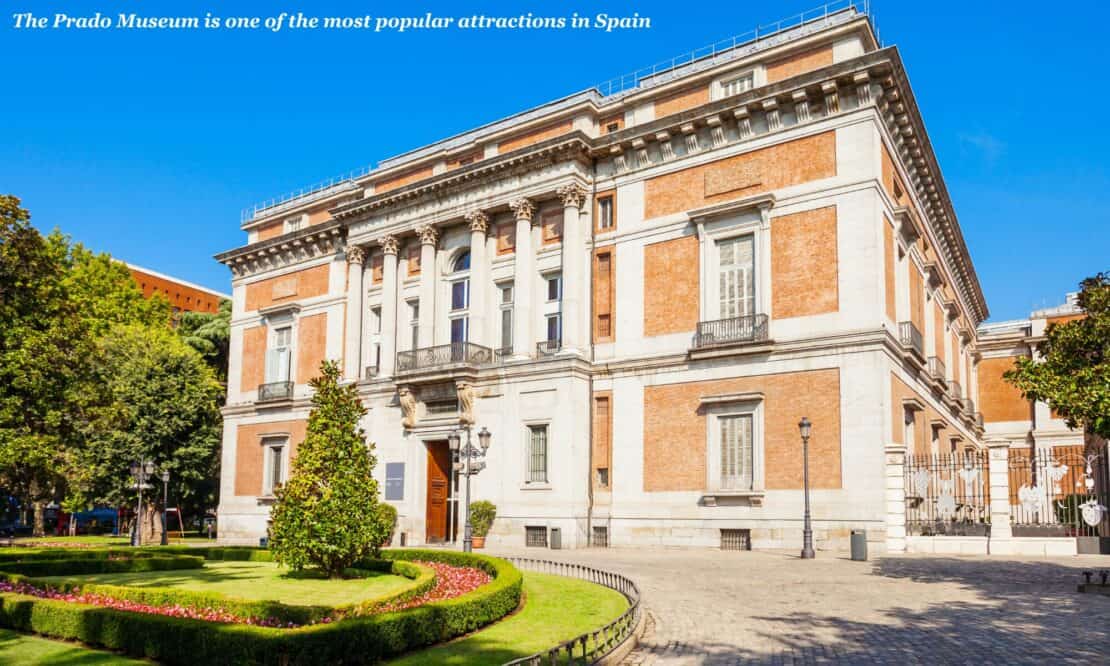
Museo Nacional del Prado
The Prado Museum is not just one of the best art museums in the world. It is, quite simply, unmissable. Walk through its hushed halls and you walk through the core of Spanish painting, and a fair bit of European painting too.
Velázquez’s Las Meninas is one of its main attractions, and if you’ve seen it in a textbook or on a postcard, it doesn’t prepare you for the moment you meet the princess and her companions in person. There’s a sense of being watched, and not just by the painter in the background.
Goya’s black paintings, meanwhile, hang like a storm cloud in a far room. They were found on the walls of his house. He never meant for anyone to see them.
Tip: The Prado is on everybody’s list, so planning ahead to avoid the additional cost of last-minute tickets is a good idea. Also, a knowledgeable tour guide can turn your visit into a great experience, even if it may incur an extra cost.
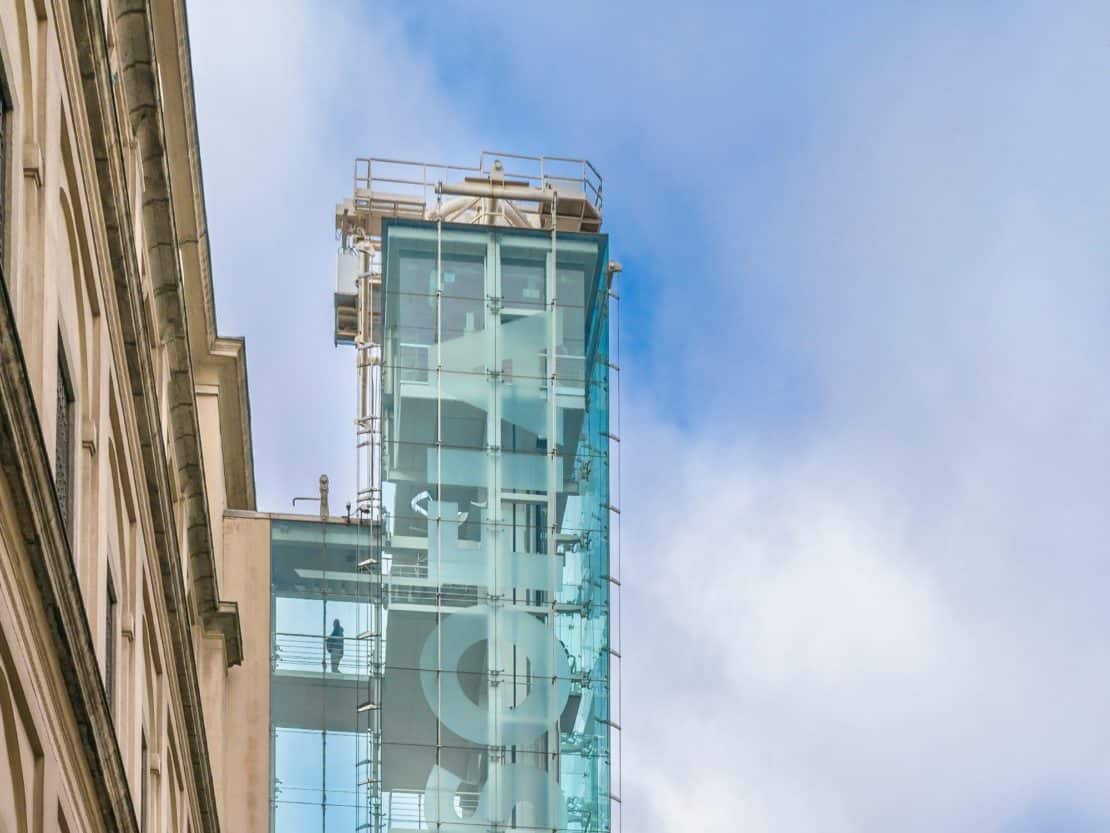
Reina Sofía Museum
If the Prado is all candlelight and courtly gloom, then Reina Sofía is bright, fragmented, and loud.
This is where you’ll find Guernica, Pablo Picasso’s monumental scream of protest against war. And it does scream – in grey and black and jagged shapes. A painting the size of a wall that somehow still manages to make you lean in closer.
There’s more. Salvador Dalí’s melting clocks hang here. So does Joan Miró’s childlike cosmos of dots and dreams.
If the Prado is the old soul of Spain, Reina Sofía is its fractured conscience, stitched together again by artists who knew pain, rebellion, and surrealism like old friends.

Thyssen-Bornemisza Museum
The third piece of the triangle is quieter. A private collection that feels, at times, like stepping into someone’s very tasteful sitting room, if that someone happened to be one of the richest collectors in Europe.
The Thyssen-Bornemisza Museum fills the gaps between Prado’s classics and Reina Sofía’s modernism. You’ll start in medieval altarpieces, pass through Renaissance gardens and Dutch interiors, and end up face-to-face with a Rothko or a Hopper.
There’s something wonderful about this balance. A bit of Impressionism. A bit of Expressionism. A Kandinsky next to a Canaletto. Somehow, it works.
Parks and Green Spaces: Madrid’s Natural Beauty
In a city known for its palaces, paintings, and stone, it’s the shade of a tree and the ripple of a quiet lake that often leave the most lasting impression.
Madrid balances its regal splendour with moments of stillness, and parks are central to the city’s daily life. Some are manicured and formal, others rugged and open, but all feel deeply woven into the rhythm of the Spanish capital.
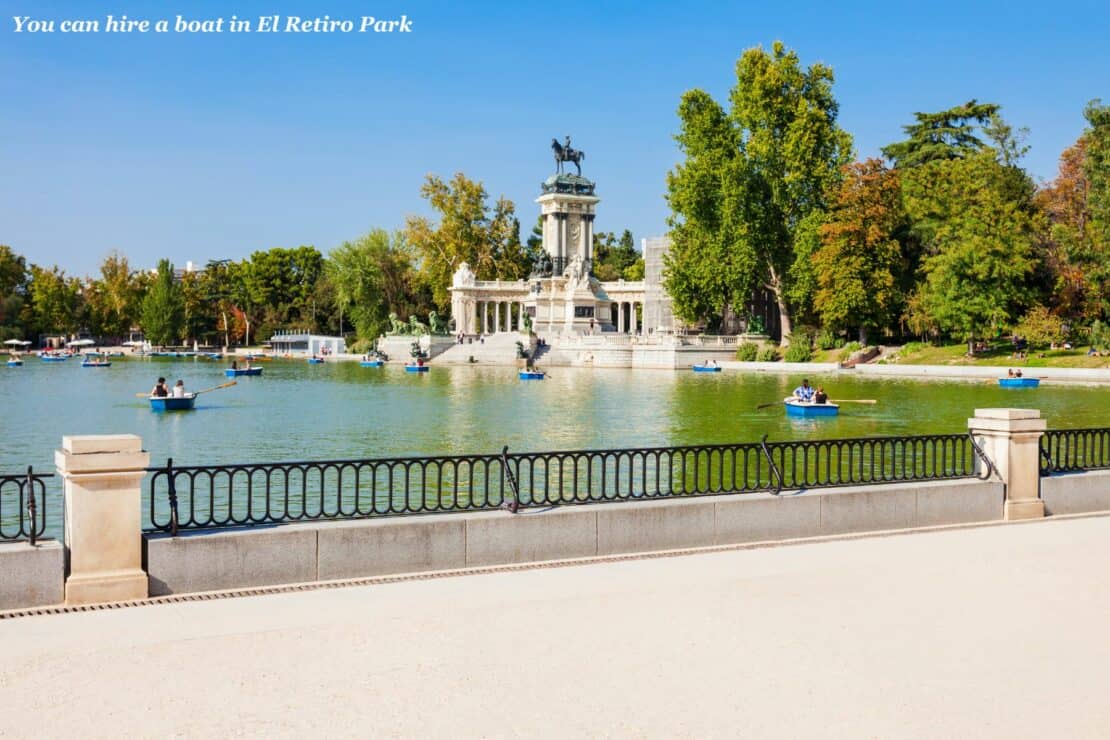
El Retiro Park – The Garden of the Capital
Once a royal playground, El Parque del Buen Retiro now belongs to everyone. Right in the city centre, just behind the Prado, this is Madrid’s own version of a central park, though with more sculpture, more sunlight, and a gentler pace.
It’s the perfect place to make hours disappear and one of the best things to do here is to hire a boat on the Grand Pond and row past the white stone colonnade.
Or wander beneath the leafy canopy toward the Palacio de Cristal (Crystal Palace), a delicate iron-and-glass pavilion that reflects the trees and sky like a still lake.
Statues of poets and generals watch from hedged alcoves. Peacocks strut near the rose beds. Locals jog, read, nap, or do nothing at all.
Casa de Campo – The Wild Side of Madrid
On the western edge of the city, Casa de Campo sprawls out with an entirely different feel. This is more of a forest where you go to escape the weight of architecture and the murmur of crowds.
Once a royal hunting ground, it now hosts walking trails perfect for outdoor activities, hidden picnic spots, and a lake where rowboats cut quiet wakes through the water.
If you’re up for a view, the cable car – Teleférico de Madrid – lifts you above the treetops, offering a skyline that stretches from the royal palace to the jagged edges of the distant Sierra de Guadarrama.
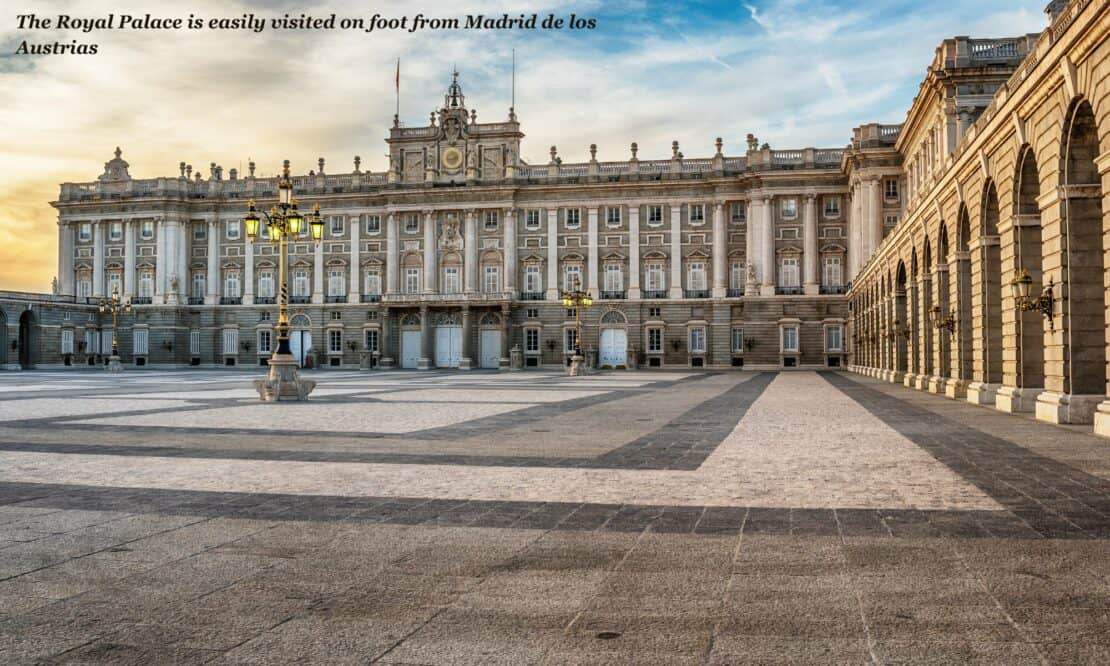
Royal Glimpses: The Palacio Real (Royal Palace of Madrid)
The Royal Palace of Madrid may no longer house the monarchy, but it still holds the weight of the empire. This vast residence, known as the Palacio Real, stands quietly proud in the western part of the city, just above the Manzanares River.
Step through its doors and you’ll find yourself surrounded by silk-lined walls, velvet thrones, and ceilings painted with allegories of power and faith.
The Throne Room feels as grand as you’d expect, with crystal chandeliers the size of small boats and tapestries whispering stories from across the centuries. There’s the Hall of Mirrors, the Royal Chapel, and the private quarters that hint at the rituals of court life long gone.
It’s easy to lose track of time here, but once you step back outside, don’t leave just yet. The Sabatini Gardens, laid out just below the palace walls, offer a good spot to pause.
With symmetrical hedges, reflecting pools, and a view of the palace rising behind them, it’s a great way to end your visit and a reminder that Madrid, too, knows how to balance power with beauty.
Culture, Streets, and Stories: Neighbourhoods to Explore
In Madrid, each barrio has its own slice of the action, from bohemian corners to literary enclaves and edgy nightlife spots.
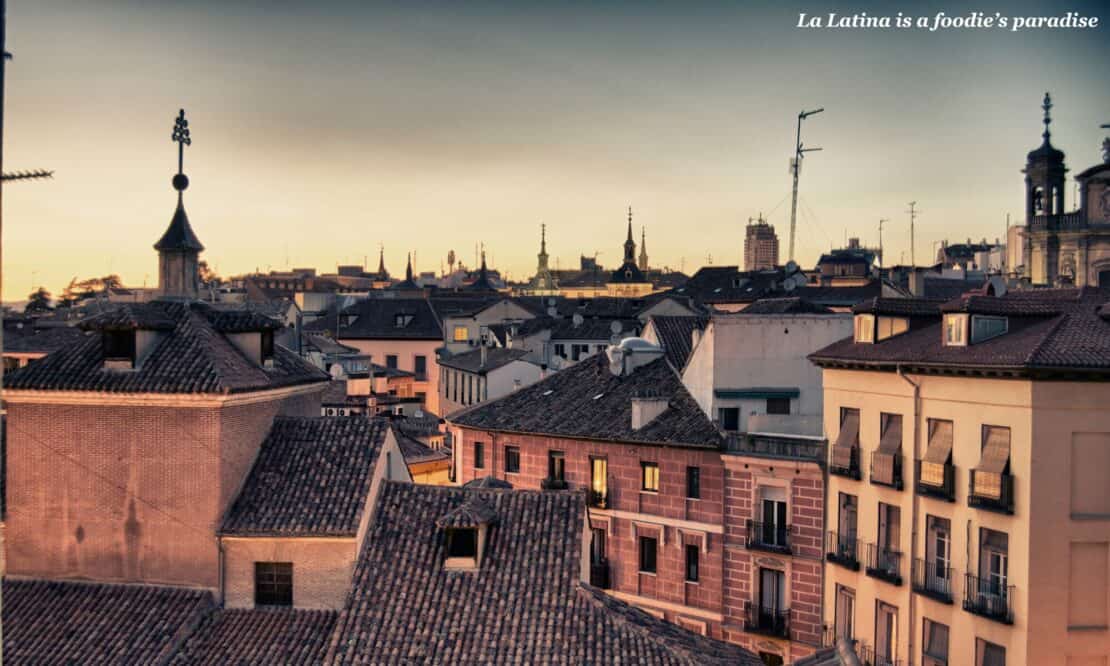
La Latina
Lined with traditional taverns, live music, and a backdrop of medieval history, La Latina is where you’ll stumble on tapas bars that hum until late.
Sundays bring the famed El Rastro, a sprawling market that sells antiques, vintage clothing, and eclectic knick-knacks. People haggle, chat, and enjoy a thoroughly local pastime, especially when street performers add to the atmosphere.
The area’s winding alleys also hide small plazas perfect for sipping morning coffee.
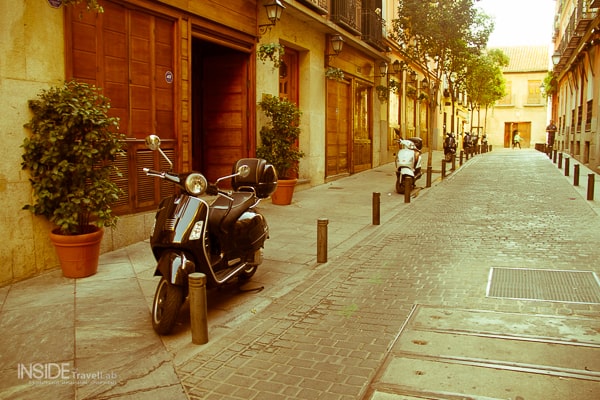
Barrio de las Letras
Steeped in the legacy of Cervantes and other Spanish Golden Age writers, Barrio de las Letras exudes a literary soul.
Pavement inscriptions quote the works of these literary giants, weaving history into your daily steps.
Beautiful architecture frames boutique hotels and cosy bookshops, creating an ambience that invites you to slow down.
In the evening, an easy walk reveals neighbourhood taverns where centuries-old décor contrasts softly lit modern design.
It’s a good place to feel the layers of Madrid’s cultural events stretching back to a time when poets and playwrights walked the same streets. You can read more about Madrid’s literary quarter here.
Malasaña & Chueca
If bohemian vibes, bold street art, and dynamic nightlife entice you, Malasaña and Chueca will feel like home. Malasaña’s alternative streak stems from the Movida Madrileña of the 1980s, manifested in graffiti-adorned walls and indie boutiques.
Calle Fuencarral cuts through, connecting it to Chueca, a famously LGBTQ+-friendly district brimming with nightlife and acceptance.
Whether you end up rummaging for vintage clothing, sampling modern fusion dishes, or mingling in a friendly bar, these two barrios show how the Spanish city evolves without discarding its traditions.

Culinary Madrid: From Tapas to Michelin Stars
The Spanish cuisine is rooted in local recipes and shaped by outside influences, culminating in a feast you’ll remember long after your flight home. From rustic taverns to glossy Michelin stars, the Spanish capital knows how to host.
Tapas in La Latina
In the old neighbourhood of La Latina, evenings stretch long across small tables. Groups spill onto the street with plates of croquetas, boquerones, grilled peppers, and thin slices of Iberian ham. No rush, no pressure. Just good company and small plates that arrive when they’re ready.
Many locals follow a casual route from Cava Baja through the surrounding streets, pausing wherever the crowd looks happiest, or the chalkboard mentions something seasonal.
House vermouth is poured on tap. And the tortilla is usually better when slightly undercooked in the centre.
The Market Scene
At Mercado de San Miguel, the glass-and-iron building just off Plaza Mayor, visitors line up for fresh oysters, jamón ibérico, goat cheese with honey, or smoked sardines on crusty bread. Each counter has its own rhythm, and you can eat standing up or drift from one to the next.
For something more local, Mercado de la Cebada and Antón Martín feel less curated and more lived-in, with fishmongers, olive vendors, and lunchtime regulars squeezing past with baskets and folded newspapers.

From Tavern to Tasting Menu
Madrid honours its past without getting stuck in it. Botín, said to be the world’s oldest restaurant, still serves roast suckling pig cooked in wood-fired ovens near Plaza Mayor.
Elsewhere, chefs like David Muñoz at DiverXO experiment wildly, without losing sight of flavour. From traditional callos in a tiled dining room to twelve-course menus in candlelit salons, the city has something for every appetite.
Want to finish your Spanish culinary adventures with a sweet treat? Don’t miss the oldest chocolatería in Madrid.

Passion in Motion: Flamenco Shows and Live Performance
You’ll hear people say flamenco comes from Andalusia, and that’s true. But Madrid is where it flourishes today. The city has drawn dancers, guitarists and singers from across Spain, and you’ll find the best of them performing in tablaos – intimate, low-lit venues where the stage is barely raised and the atmosphere does most of the work.
Corral de la Morería is often cited as the most iconic, a great place where tradition lives side by side with theatrical flair.
Elsewhere, Cardamomo keeps things raw and grounded, the kind of setting where the beat of a heel or the rasp of a voice feels closer than the glass in your hand.
Football, Fervour and Real Madrid
For many Madrileños, football is a cultural hallmark. Santiago Bernabéu Stadium, the home turf of Real Madrid, echoes with roars that unite fans from across the globe. The stadium tour lets you trace the footsteps of legends, peek into dressing rooms, and witness a trophy collection that reads like a timeline of Europe’s football achievements.
Excursions: Find the Best Day Trips from Madrid
Madrid sits at the heart of the rest of Spain, rendering day trips to surrounding regions an easy proposition. After days exploring big city avenues, a quick train ride or bus journey whisks you away to centuries-old towns and UNESCO World Heritage Site marvels.
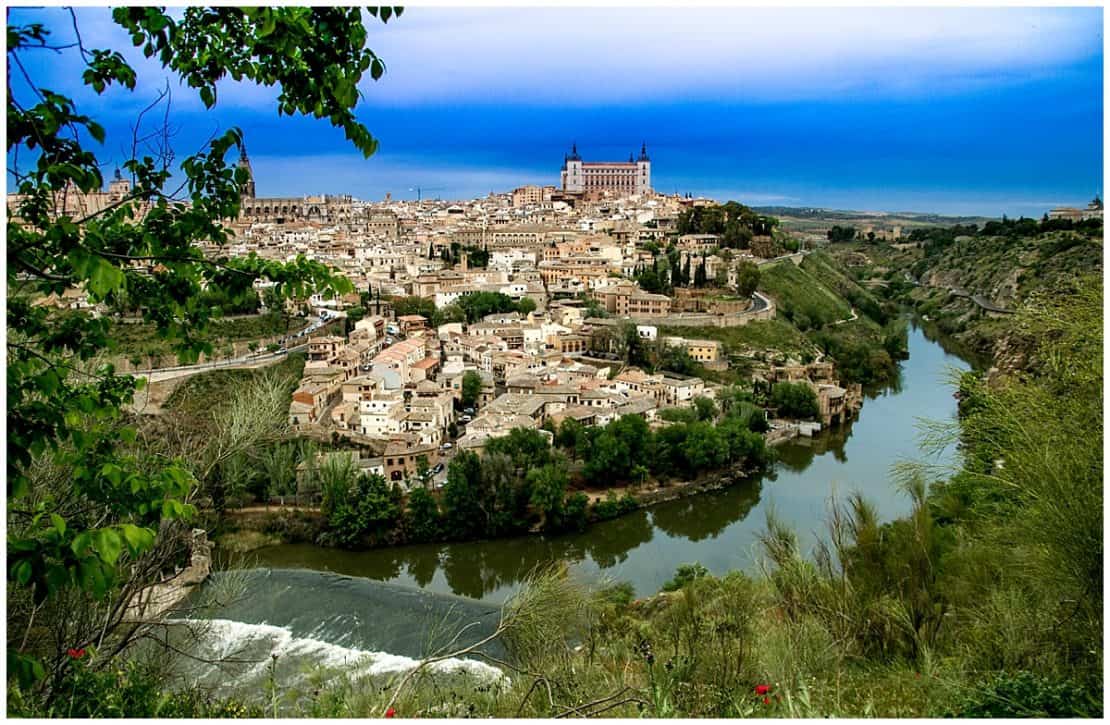
Toledo
Less than an hour away by train, Toledo once served as the capital of Spain and still holds a magnetic presence. Winding cobbled lanes climb toward an ancient skyline of church spires and fortress walls.
The city has long been known for its coexistence of Christian, Jewish, and Muslim communities, and you can still see the layers in the architecture and layout – Gothic cathedrals, Sephardic synagogues, and Mudéjar arches all within a short walk.
Toledo is also the city of El Greco, and his elongated saints haunt the halls of churches and museums alike. Come for the views, the marzipan, and the sharpness of its steel blades, stay for the sense of timelessness.
Segovia
Segovia rises on a rocky hill, crowned by a fairytale Alcázar that’s said to have inspired Walt Disney. Just below it, a Roman aqueduct stretches more than 800 metres, its arches still intact after nearly 2,000 years.
This is a place that feels theatrical in the best way – bold, beautiful, and entirely intact.
You can try the local speciality, cochinillo (roast suckling pig), before climbing the Alcázar tower for sweeping views of Castile’s rolling plains.

El Escorial and Beyond
Northwest of Madrid, El Escorial is a vast royal complex that combines a palace, monastery, and mausoleum. Its scale is impressive and its purpose deeply political, as it was built by Philip II to assert power and piety in one gesture.
Other nearby tourist attractions include Ávila, with its near-perfect medieval walls, and Salamanca, a university city with golden stone, brilliant light and one very famous resident – here’s what you need to know about the Salamanca frog.
Each one makes a perfect spot to see a different side of Spain. Find more information about the best places to stay in Madrid here.
Getting Around Madrid
Madrid’s large-scale public transportation network underpins its reputation as a capital city that is surprisingly navigable. The Metro forms the backbone, whisking you from the city centre to outer districts in minutes.
Buses fill in the gaps, connecting neighbourhoods often missed by underground lines.
Should you need an unplanned route or late-night drop-off, taxis and rideshares wait on busy streets or can be summoned by apps.
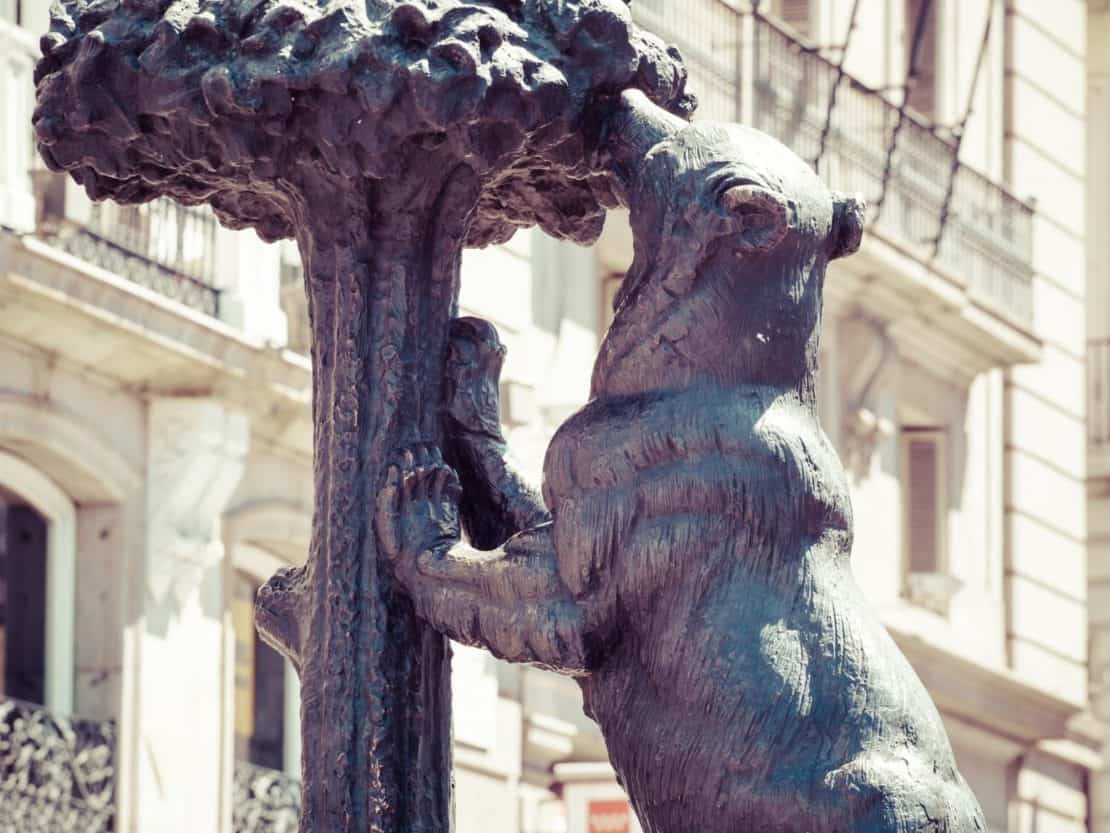
The Best Time to Visit Madrid
Madrid wears each season differently. Unlike coastal cities, where the calendar is tied to the sea, the Spanish capital shifts in character throughout the year, and each change offers a different kind of experience.
Spring and Autumn: A Gentle Goldilocks
Late March through May, and again from mid-September to early November, are often considered the ideal months to visit. The heat softens, the light is kinder, and the parks come alive with jacaranda blooms or golden leaves.
Outdoor terraces fill steadily but not chaotically. These seasons bring a calmer rhythm, perfect for walking the Paseo del Prado, lingering in El Retiro Park, or slipping into a shaded courtyard with a coffee and no plan at all.

Summer: Light, Long Days and Strong Sun
The Mediterranean climate means summer months that stretch long and hot. July and August regularly cross 35°C, and locals often escape the heat by heading north or to the coast.
But for those who stay, Madrid has its own rhythm – late nights, shaded mornings, and cultural events that begin well after sundown.
Rooftop bars stay open late. Museums offer air-conditioned refuge. If you don’t mind the heat, this is when the city feels most alive after dark.
Winter: Brisk Days, Clear Skies
Madrid’s winters are surprisingly pleasant. Days are crisp but bright, with temperatures often hovering around 10–15°C. It’s a good time for museum visits, festive lights, and hearty stews in warm tavernas. And with fewer tourists, everything feels more spacious.
Where to Stay in Madrid
Madrid is a city of neighbourhoods, each with its own atmosphere. Where you stay can shape your experience.
Salamanca: Elegance and Quiet
Barrio de Salamanca is Madrid’s most refined quarter, known for wide boulevards, luxury brands, and handsome 19th-century architecture.
It’s home to high-end boutiques, quiet cafés, and several Michelin-starred restaurants, making it a popular choice for those who like their evenings peaceful, and their surroundings polished.
Hotels here often come with an additional cost, but in exchange, you’ll sleep in serene comfort just a short taxi ride from the city centre.
Retiro: Near the Park, Near the Museums
If you prefer mornings that begin with a stroll among trees, consider the Retiro area. It borders the park and offers easy access to the Golden Triangle of museums.
Some boutique hotels here focus on sustainability and modern design, while others lean into classical elegance. The vibe is more residential than touristy, which means quieter streets and a local rhythm.
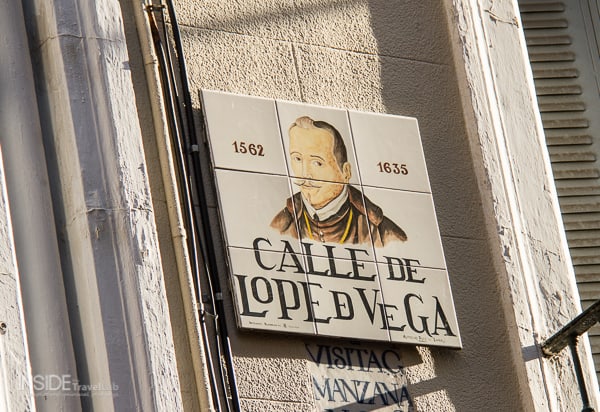
Barrio de las Letras: Literary Charm in the Heart of the City
For character and convenience, Barrio de las Letras is hard to beat. Once home to writers like Cervantes and Lope de Vega, this area now buzzes with bookshops, wine bars, and well-located boutique hotels. It sits comfortably between Sol, Lavapiés, and the museum district, a central location without the chaos.
Final Verdict: Is Madrid Worth Visiting?
Yes, Madrid is worth visiting, but not in the way some Spanish cities (or European cities) overwhelm you at first glance. It doesn’t rely on a single icon or one dramatic skyline. Instead, it draws you in slowly, with long evenings, lived-in neighbourhoods, and a sense of ease that deepens the longer you stay.
For anyone interested in Spanish culture – the real, layered kind – this is the place to come. You’ll learn more about the country’s history in a single morning at the Prado than in hours of reading. You’ll hear the soul of the south in a flamenco show, taste the north in a plate of bacalao al pil-pil, and see the future in a modern gallery tucked inside an old courtyard.
Madrid isn’t built for postcard moments. It’s built for presence. You walk, you eat, you watch the world go by. And somewhere between a first coffee and a final glass of wine, it finds its way into your memory.
Find flights Miami to Madrid here.
More About Spain
- 31 fun facts about Madrid
- Inside Madrid’s literary quarter
- Eating churros at the oldest chocolatería in Madrid
- The best neighbourhoods to stay in Madrid
- How to find the Salamanca frog and what it means
- Everything you need to know about travelling solo in Spain
- How to get off the beaten track in Spain
- How to spend the perfect week in Spain
- 21 unique and unusual things to do in Spain
- The ultimate Spain packing list




